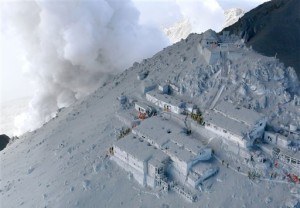At least 36 people are believed to have died from this weekend’s eruption at Mt. Ontake in central Japan, as dangerous gases emitting from the country’s second-highest volcano hampered efforts to recover victims.
Twelve bodies have been retrieved from the mountain since yesterday and were declared dead, public broadcaster NHK reported. Crews were forced to suspend operations yesterday and this afternoon to avoid being overtaken by sulphurous gases emitting from the volcano’s vent, said Soshi Shiotani, an official at the Fire and Disaster Management Agency.

Smoke and ash have billowed from Ontake since the eruption shortly before noon on Sept. 27, as efforts continued to find missing hikers and bring down the injured. The Japan Meteorological Agency said in a statement that the eruption could be a precursor to further bursts of volcanic activity.
“The rescuers would have stopped due to high levels of gas,” Shane Cronin, an earth science professor who specializes in volcanoes at New Zealand’s Massey University, said in an e- mail. “With gas in the eyes and acid impacts on the skin, it rapidly becomes a very unpleasant and dangerous environment to work in.”
The Fire and Disaster Management Agency said this morning it was in the process of revising the number of people unaccounted for. The agency put that number at 45 yesterday.
Missing Hikers
Eight of the 303 people who filled out safety registration cards before climbing the mountain were still missing, Chief Cabinet Secretary Yoshihide Suga told reporters today. It’s possible that hikers who did not fill out the card could still be unaccounted for, he said.
Six employees of Sompo Japan Nipponkoa Holdings Inc., a Tokyo-based insurance company, went missing during a hike on the mountain, spokesman Kenichi Iino said today by phone. Three other staffers from the group made the descent safely.
Nissay Asset Management Corp. spokesman Tatsuro Ejiri said three of its employees were also missing.
“For the moment, the top priority is to focus on the rescue of those found without a pulse and those who have fallen out of contact,” Suga said.
Suga said 420 people were confirmed to have come down from the mountain. Seven climbers were flown off the mountain yesterday and some were hospitalized, NHK reported. About 1,160 police, fire and military personnel were aiding the rescue effort today, Suga said.
U.S. Ambassador Caroline Kennedy expressed her condolences to the families and friends of those affected by the eruption in a statement today.
‘Pyroclastic Flow’
Five more victims were found without vital signs on the mountainside today, in addition to the 31 yesterday, said the Nagano prefectural police official who asked not to be identified, citing agency policy.
The four men taken off the mountain yesterday were declared dead this morning, the official said. They are Yusuke Asai, 23, of Nagoya city; Isamu Miura, 45, of Gifu city; Takuji Hayashi, 54, of Shiojiri city in Nagano prefecture; and Kazumasa Yokota, 61, of Matsumoto city in Nagano prefecture, the official said.
The victims were likely killed by a pyroclastic flow, a violent burst of gas, rocks and smoke that burst from the volcano’s vent, burying everything in its path, said Massey University’s Cronin.
“The most likely cause of deaths in the central parts of these flows is due to impact of large, fast-moving rock clasts—particles that can be several meters in diameter down to pebble-sized rocks and ash,” he said. “They probably died almost instantaneously from the violence of the blast-like current.”
Clear Skies
Ontake, which straddles Nagano and Gifu prefectures, offers scenic views of the 3,000-meter peaks of Japan’s Northern and Southern Alps.
Clear skies two days ago would have drawn an especially large number of hikers to the mountain’s popular trails, Arata Matsunaga, a staff member at the tourism association in Nagano prefecture’s Kiso town, said yesterday by phone.
Hikers had unrestricted access to Mt. Ontake on Saturday, with seismologists detecting low levels of volcanic activity prior to the eruption, the Meteorological Agency said. Volcanic activity was at an even lower frequency than that recorded before a smaller Ontake eruption in 2007, according to the agency.
Opening Phase
Web camera images from a nearby tourist site showed an ashy white haze billowing from the volcano’s craters, in stark contrast to the gray clouds that spread over the mountain’s contours soon after the eruption.
“Often activity continues for quite some time at these types of volcanoes,” Charles Connor, a geophysicist specializing in volcanoes at the University of South Florida, said by phone. “It would not be unusual for this to be a relatively low volume sort of opening phase of a higher level of activity at the volcano.”
Japan lies on the so-called “Ring of Fire,” an arc of volcanoes and fault lines surrounding the Pacific Basin, and it sits at the three-way meeting point of the North American, Eurasian and Philippine Sea tectonic plates.
Ontake is one of more than 100 active volcanoes in Japan.
The last previous fatalities from volcanic activity in Japan were 43 people killed in the 1991 eruption of Mt. Unzen, on Japan’s southernmost island of Kyushu.
–With assistance from Brian Fowler, Hideki Sagiike, Eijiro Ueno, Masumi Suga, Isabel Reynolds, Maiko Takahashi and Rin Ichino in Tokyo.





















 Hawaii’s Housing Market Faces Challenges Due to Construction Defect Litigation: Study
Hawaii’s Housing Market Faces Challenges Due to Construction Defect Litigation: Study  ‘Bleak’ Data: Insurance Co. Entry Level Hiring Expectations Hit Low Point
‘Bleak’ Data: Insurance Co. Entry Level Hiring Expectations Hit Low Point  Investigations to Legislation: Florida Lawmakers Weighing Insurance Industry Changes
Investigations to Legislation: Florida Lawmakers Weighing Insurance Industry Changes  California Commissioner ‘Provisionally’ OKs State Farm’s Rate Request
California Commissioner ‘Provisionally’ OKs State Farm’s Rate Request 





